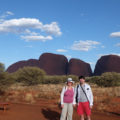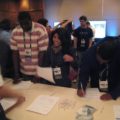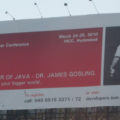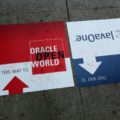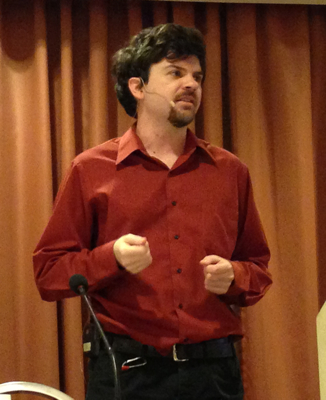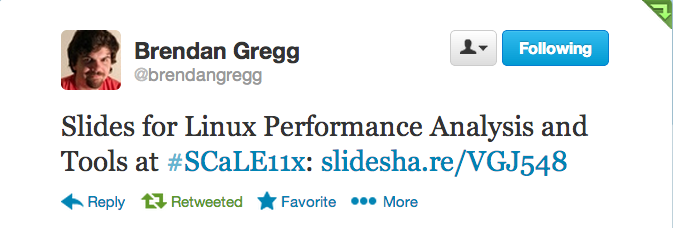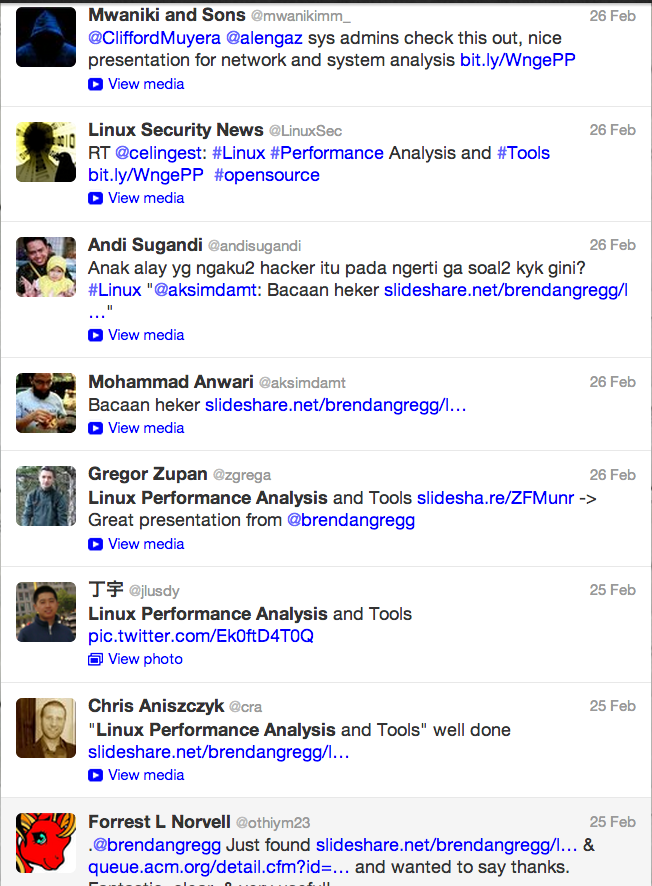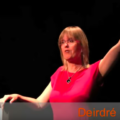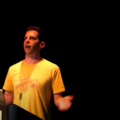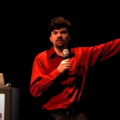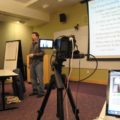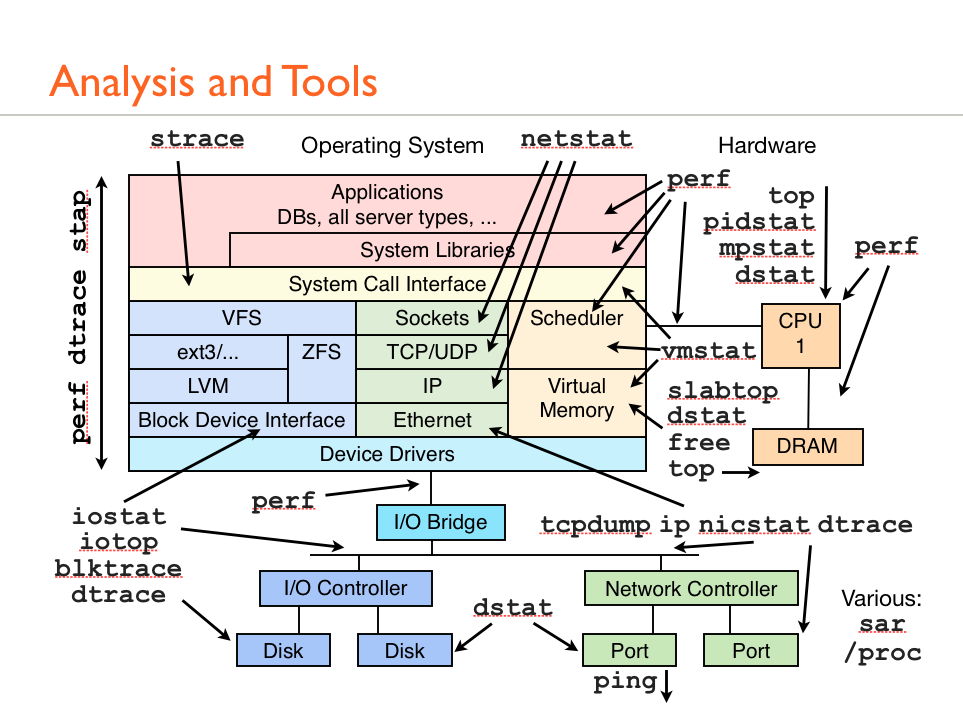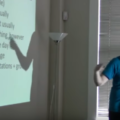| Event: |
|
Event Date |
|
Title |
|
Video |
|
Speaker |
| ad hoc |
|
2013-04 |
|
Brendan Writing a Book on Bart |
|
Link |
|
Brendan Gregg |
| SCaLE 2013 |
|
2013-02 |
|
Linux Systems Performance |
|
Link |
|
Brendan Gregg |
| CACM |
|
2013-02 |
|
Thinking Methodically about Performance,… |
|
Link |
|
Brendan Gregg |
| illumos / ZFS Days |
|
2012-10 |
|
Building a Business on illumos |
|
Link |
|
Rod Boothby and panel |
| illumos / ZFS Days |
|
2012-10 |
|
Darwin’s Storage |
|
Link |
|
|
| at Joyent |
|
2012-10 |
|
DevOps Demystified – An introduction to th |
|
Link |
|
Ben Rockwood |
| illumos / ZFS Days |
|
2012-10 |
|
DTracing the Cloud |
|
Link |
|
|
| illumos / ZFS Days |
|
2012-10 |
|
Enhanced OS Virtualization for the Cloud |
|
Link |
|
Jerry Jelinek |
| illumos / ZFS Days |
|
2012-10 |
|
Hybrid Storage Pools: Using Disk and Fla… |
|
Link |
|
Adam Leventhal |
| illumos / ZFS Days |
|
2012-10 |
|
illumos Day: Chris Nelson, Bayard Bell, R… |
|
Link |
|
|
| illumos / ZFS Days |
|
2012-10 |
|
illumos Day: illumos Innovations That Will… |
|
Link |
|
Adam Leventhal |
| illumos / ZFS Days |
|
2012-10 |
|
Making the Impossible Possible: Disposab… |
|
Link |
|
Eric Sproul of OmniTI |
| illumos / ZFS Days |
|
2012-10 |
|
Running Without a ZFS Root Pool |
|
Link |
|
|
| illumos / ZFS Days |
|
2012-10 |
|
SmartOS Operations — Ben Rockwood at |
|
Link |
|
Ben Rockwood |
| illumos / ZFS Days |
|
2012-10 |
|
The illumos Home Data Center |
|
Link |
|
Dan McDonald of Nexenta |
| illumos / ZFS Days |
|
2012-10 |
|
Why 4K? |
|
Link |
|
George Wilson |
| illumos / ZFS Days |
|
2012-10 |
|
ZFS Day Panel: The State of ZFS o |
|
Link |
|
Matt Ahrens and panel |
| illumos / ZFS Days |
|
2012-10 |
|
ZFS Day: Architecting ZFS Solutions UStream |
|
Link |
|
|
| illumos / ZFS Days |
|
2012-10 |
|
ZFS Day: George Wilson |
|
Link |
|
|
| illumos / ZFS Days |
|
2012-10 |
|
ZFS Day: Justin Gibbs and Will Andrews,… |
|
Link |
|
|
| illumos / ZFS Days |
|
2012-10 |
|
ZFS Performance Analysis and Tools |
|
Link |
|
Brendan Gregg |
| illumos / ZFS Days |
|
2012-10 |
|
ZFS State of the Union |
|
Link |
|
Matt Ahrens of Delphix |
| BayLISA |
|
2012-08 |
|
Adding Per-Thread Caching to libumem |
|
Link |
|
Robert Mustacchi |
| BayLISA |
|
2012-08 |
|
Adding Per-Thread Caching to libumem (footnote) |
|
Link |
|
Bryan Cantrill |
| BayLisa at Joyent 2012 |
|
2012-08 |
|
DTrace in the Non-Global Zone |
|
Link |
|
Bryan Cantrill |
| BayLISA |
|
2012-08 |
|
Introduction to SmartOS |
|
Link |
|
Bryan Cantrill |
| BayLISA |
|
2012-08 |
|
SmartOS ZFS Architecture |
|
Link |
|
Bill Pijewski |
| BayLISA |
|
2012-08 |
|
SmartOS: An SA Primer |
|
Link |
|
Ben Rockwood |
| FISL, July 2012 |
|
2012-07 |
|
Corporate Open Source Anti-Patterns: Doi… HD |
|
Link |
|
Bryan Cantrill |
| FISL, July 2012 |
|
2012-07 |
|
Introduction to Git |
|
Link |
|
Randal Schwartz |
| FISL, July 2012 |
|
2012-07 |
|
Performance Analysis: The USE Method HD |
|
Link |
|
Brendan Gregg |
| FISL, July 2012 |
|
2012-07 |
|
Using Video to Communicate Technology HD |
|
Link |
|
Deirdré Straughan |
| NOSIG |
|
2012-06 |
|
Max Bruning at NOSIG HD |
|
Link |
|
Max Bruning |
| SVLUG May 2,012 |
|
2012-05 |
|
illumos Hardware Support |
|
Link |
|
Bryan Cantrill |
| SVLUG May 2,012 |
|
2012-05 |
|
illumos Key Technologies |
|
Link |
|
Bryan Cantrill |
| SVLUG May 2,012 |
|
2012-05 |
|
illumos Technologies for Embedded Systems |
|
Link |
|
Bryan Cantrill |
| SVLUG May 2,012 |
|
2012-05 |
|
Packaging in illumos |
|
Link |
|
Bryan Cantrill |
| SVLUG May 2,012 |
|
2012-05 |
|
SVLUG Comparative Operating Systems … 1st hour |
|
Link |
|
Bryan Cantrill |
| SVLUG May 2012 |
|
2012-05 |
|
SVLUG Comparative Operating Systems… 2nd hour |
|
Link |
|
Bryan Cantrill |
| SVLUG May 2,012 |
|
2012-05 |
|
Virtualization and the Future of illumo |
|
Link |
|
Bryan Cantrill |
| SVLUG May 2,012 |
|
2012-05 |
|
Why You Need ZFS |
|
Link |
|
Bryan Cantrill |
| dtrace.conf 2012 |
|
2012-04 |
|
A Carousel of DTrace |
|
Link |
|
various |
| dtrace.conf 2012 |
|
2012-04 |
|
dtrace.conf 12 – Barriers to DTrace Adoption |
|
Link |
|
|
| dtrace.conf 2012 |
|
2012-04 |
|
dtrace.conf 2012 – Clang Parser for DTrace |
|
Link |
|
|
| dtrace.conf 2012 |
|
2012-04 |
|
dtrace.conf 2012 – Control Flow & Langua… |
|
Link |
|
|
| dtrace.conf 2012 |
|
2012-04 |
|
dtrace.conf 2012 – DTrace and Erlang |
|
Link |
|
Scott Fritchie |
| dtrace.conf 2012 |
|
2012-04 |
|
dtrace.conf 2012 – DTrace in node.js |
|
Link |
|
|
| dtrace.conf 2012 |
|
2012-04 |
|
dtrace.conf 2012 – DTrace on FreeBSD |
|
Link |
|
|
| dtrace.conf 2012 |
|
2012-04 |
|
dtrace.conf 2012 – DTrace on Linux |
|
Link |
|
|
| dtrace.conf 2012 |
|
2012-04 |
|
dtrace.conf 2012 – DTrace State of the Union |
|
Link |
|
Bryan Cantrill |
| dtrace.conf 2012 |
|
2012-04 |
|
dtrace.conf 2012 – More Visualizations |
|
Link |
|
|
| dtrace.conf 2012 |
|
2012-04 |
|
dtrace.conf 2012 – Setting the Agenda |
|
Link |
|
Bryan Cantrill |
| dtrace.conf 2012 |
|
2012-04 |
|
dtrace.conf 2012 – Visualizations |
|
Link |
|
Brendan Gregg |
| dtrace.conf 2012 |
|
2012-04 |
|
dtrace.conf 2012 – Visualizations, Enabling… |
|
Link |
|
|
| dtrace.conf 2012 |
|
2012-04 |
|
dtrace.conf 2012 – ZFS Provider |
|
Link |
|
|
| dtrace.conf 2012 |
|
2012-04 |
|
dtrace.conf 2012- Dynamic Translators |
|
Link |
|
|
| dtrace.conf 2012 |
|
2012-04 |
|
dtrace.conf 2012- User-Level CTF |
|
Link |
|
|
| ad hoc |
|
2012-03 |
|
Converting Virtual Appliance Packages for |
|
Link |
|
Orlando Vazquez |
| SCALE, Jan 2012 |
|
2012-01 |
|
Developing for illumos – 1 HD |
|
Link |
|
Garrett D’Amore |
| SCALE, Jan 2012 |
|
2012-01 |
|
Developing for illumos – 2 HD |
|
Link |
|
Garrett D’Amore |
| SCALE, Jan 2012 |
|
2012-01 |
|
Developing for illumos – 3 HD |
|
Link |
|
Garrett D’Amore |
| SCALE, Jan 2012 |
|
2012-01 |
|
Developing for illumos – 4 HD |
|
Link |
|
Garrett D’Amore |
| SCALE, Jan 2012 |
|
2012-01 |
|
Developing for illumos – 5 HD |
|
Link |
|
Garrett D’Amore |
| SCALE, Jan 2012 |
|
2012-01 |
|
Developing for illumos – 5 HD |
|
Link |
|
Garrett D’Amore |
| SCALE, Jan 2012 |
|
2012-01 |
|
Experiences Starting an Open Source Ope… 1 |
|
Link |
|
Garrett D’Amore |
| SCALE, Jan 2012 |
|
2012-01 |
|
Experiences Starting an Open Source Ope… 2 |
|
Link |
|
Garrett D’Amore |
| SCALE, Jan 2012 |
|
2012-01 |
|
Experiences Starting an Open Source Ope… 3 |
|
Link |
|
Garrett D’Amore |
| SCALE, Jan 2012 |
|
2012-01 |
|
Experiences Starting an Open Source Ope… 4 |
|
Link |
|
Garrett D’Amore |
| SCALE, Jan 2012 |
|
2012-01 |
|
Experiences Starting an Open Source Ope… 4 |
|
Link |
|
Garrett D’Amore |
| SCALE, Jan 2012 |
|
2012-01 |
|
Performance Analysis: new tools and co 1 |
|
Link |
|
Brendan Gregg |
| SCALE, Jan 2012 |
|
2012-01 |
|
Performance Analysis: new tools and co 2 |
|
Link |
|
Brendan Gregg |
| SCALE, Jan 2012 |
|
2012-01 |
|
Performance Analysis: new tools and co 3 |
|
Link Brendan Gregg |
| SCALE, Jan 2012 |
|
2012-01 |
|
Performance Analysis: new tools and co 4 |
|
Link |
|
Brendan Gregg |
| illumos user group Jan 2,012 |
|
2012-01 |
|
Testing ZFS in illumos |
|
Link |
|
Delphix |
| illumos user group Jan 2,012 |
|
2012-01 |
|
The Future of LibZFS – Part 3 HD |
|
Link |
|
Matt Ahrens |
| illumos user group Jan 2,012 |
|
2012-01 |
|
The Future of LibZFS Part 1 HD |
|
Link |
|
Matt Ahrens |
| illumos user group Jan 2,012 |
|
2012-01 |
|
The Future of LibZFS, Part 2 HD |
|
Link |
|
Matt Ahrens |
| SCALE, Jan 2012 |
|
2012-01 |
|
Using SmartOS as a Hypervisor – 1 |
|
Link |
|
Robert Mustacchi |
| SCALE, Jan 2012 |
|
2012-01 |
|
Using SmartOS as a Hypervisor – 2 |
|
Link Robert Mustacchi |
| SCALE, Jan 2012 |
|
2012-01 |
|
Using SmartOS as a Hypervisor – 3 |
|
Link |
|
Robert Mustacchi |
| SCALE, Jan 2012 |
|
2012-01 |
|
Using SmartOS as a Hypervisor – 4 |
|
Link |
|
Robert Mustacchi |
| SCALE, Jan 2012 |
|
2012-01 |
|
Using SmartOS as a Hypervisor – 5 |
|
Link Robert Mustacchi |
| illumos user group Jan 2,012 |
|
2012-01 |
|
ZFS Backwards Compatibility Testing with … HD |
|
Link |
|
Delphix |
| illumos user group Jan 2,012 |
|
2012-01 |
|
ZFS Code Comments HD |
|
Link |
|
Bryan Cantrill |
| illumos user group Jan 2012 |
|
2012-01 |
|
ZFS Feature Flags – Part 1 HD |
|
Link |
|
Delphix |
| illumos user group Jan 2,012 |
|
2012-01 |
|
ZFS Feature Flags – Part 2 HD |
|
Link |
|
Delphix |
| illumos user group Jan 2,012 |
|
2012-01 |
|
ZFS Feature Flags – Part 3 HD |
|
Link Delphix |
| USENIX LISA 2011 |
|
2011-12 |
|
Fork Yeah! The Rise and Development of illumos |
|
Link |
|
Bryan Cantrill |
| USENIX LISA 2011 |
|
2011-12 |
|
The DevOps Transformation |
|
Link |
|
Ben Rockwood |
| ad hoc |
|
2011-11 |
|
The DTrace Book and Solaris 11 |
|
Link Brendan Gregg |
| Solaris Family Reunion at Joyent, Oct 2011 |
|
2011-10 |
|
Solaris Family Reunion |
|
Link |
|
Bryan Cantrill |
| Surge 2011 |
|
2011-09 |
|
Building a Real-Time Cloud Analytics Service with Node.js |
|
Link |
|
Bryan Cantrill |
| KVM Conf 2011 |
|
2011-08 |
|
Experiences Porting KVM to SmartOS |
|
Link |
|
Bryan Cantrill |
| at Joyent |
|
2011-07 |
|
Computing History with Bryan Cantrill |
|
Link |
|
Bryan Cantrill |
| at Joyent |
|
2011-07 |
|
Computing History with Bryan Cantrill Part 2 |
|
Link |
|
Bryan Cantrill |
| at Joyent |
|
2011-07 |
|
Visualizing Latency with Heatmaps |
|
Link |
|
Dave Pacheco |
| at Joyent |
|
2011-06 |
|
Cloud Analytics Advanced Visualization |
|
Link |
|
Brendan Gregg |
| at Joyent |
|
2011-06 |
|
Cloud Analytics Basic Visualization |
|
Link |
|
Brendan Gregg |
|
|
2011-06 |
|
Cloud Analytics Definitions and Context |
|
Link |
|
Brendan Gregg |
| at Joyent |
|
2011-06 |
|
Cloud Analytics Ease of Use |
|
Link |
|
Brendan Gregg |
| at Joyent |
|
2011-06 |
|
MySQL Query Latency with DTrace 1 |
|
Link |
|
Brendan Gregg |
| at Joyent |
|
2011-06 |
|
MySQL Query Latency with DTrace 2 |
|
Link |
|
Brendan Gregg |
| at Joyent |
|
2011-06 |
|
MySQL Query Latency with DTrace 3 |
|
Link |
|
Brendan Gregg |
| at Joyent |
|
2011-06 |
|
MySQL Query Latency with DTrace 4 |
|
Link |
|
Brendan Gregg |
| at Joyent |
|
2011-06 |
|
MySQL Query Latency with DTrace 5 |
|
Link |
|
Brendan Gregg |
| Velocity |
|
2011-06 |
|
The Best of Velocity – Instrumenting the real-time web: Node.js, DTrace and the Robinson Projection |
|
Link |
|
Bryan Cantrill |
| illumos user group |
|
2011-06 |
|
Illumos Meetup 1 |
|
Link |
|
various |
| illumos user group |
|
2011-06 |
|
Illumos Meetup 2 |
|
Link |
|
various |
| illumos user group |
|
2011-06 |
|
Illumos Meetup 3 |
|
Link |
|
various |
| illumos user group |
|
2011-06 |
|
Illumos Meetup 4 |
|
Link |
|
various |
| illumos user group |
|
2011-06 |
|
Illumos Meetup 5 |
|
Link |
|
various |
| illumos user group |
|
2011-06 |
|
Illumos Meetup 6 |
|
Link |
|
various |
| at Joyent |
|
2011-05 |
|
SmartDataCenter Performance Disk IO Throttling for Optimal Performance |
|
Link |
|
Bill Pijewski |
| at Joyent |
|
2011-04 |
|
mpstat All the Fields |
|
Link |
|
Brendan Gregg |
| at Joyent |
|
2011-04 |
|
mpstat Digging Deeper |
|
Link |
|
Brendan Gregg |
| at Joyent |
|
2011-04 |
|
mpstat Key Fields |
|
Link |
|
Brendan Gregg |
| at Joyent |
|
2011-04 |
|
uptime Load Averages |
|
Link |
|
Brendan Gregg |
| node.js Community Event March 1, 2011 |
|
2011-03 |
|
Cloud Analytics Screencast |
|
Link |
|
Bryan Cantrill, Brendan Gregg |
| Vancouver, Jan 2011 |
|
2011-01 |
|
SmartOS Diskless Boot |
|
Link |
|
Bryan Cantrill |
| USENIX LISA 2010 |
|
2010-12 |
|
Visualizations for Performance Analysis (and More) – USENIX copy |
|
Link |
|
Brendan Gregg |
| USENIX LISA 2010 |
|
2010-11 |
|
DTrace BoF at LISA10 |
|
Link |
|
Brendan Gregg, Jim Mauro |
| USENIX LISA 2010 |
|
2010-11 |
|
DTrace BoF at LISA10 Part 2 |
|
Link |
|
Brendan Gregg, Jim Mauro |
| Solaris Summit at USENIX LISA 2010 |
|
2010-11 |
|
IPS Part 2 |
|
Link |
|
Bart Smaalders |
| Solaris Summit at USENIX LISA 2010 |
|
2010-11 |
|
IPS Part 3 |
|
Link |
|
Bart Smaalders |
| USENIX LISA 2010 |
|
2010-11 |
|
lisa10-vijay2 |
|
Link |
|
|
| Solaris Summit at USENIX LISA 2010 |
|
2010-11 |
|
New Security Features in Oracle Solaris 11 Express |
|
Link |
|
|
| Solaris Summit at USENIX LISA 2010 |
|
2010-11 |
|
Solaris 11 Deployment, 1 of 3 |
|
Link |
|
|
| Solaris Summit at USENIX LISA 2,010 |
|
2010-11 |
|
Solaris 11 Deployment, 2 of 3 |
|
Link |
|
|
| Solaris Summit at USENIX LISA 2,010 |
|
2010-11 |
|
Solaris 11 Deployment, 3 of 3 |
|
Link |
|
|
| Solaris Summit at USENIX LISA 2,010 |
|
2010-11 |
|
Solaris 11 Engineering Panel |
|
Link |
|
|
| Solaris Summit at USENIX LISA 2,010 |
|
2010-11 |
|
Solaris 11 Engineering Panel 2 |
|
Link |
|
|
| Solaris Summit at USENIX LISA 2,010 |
|
2010-11 |
|
Solaris 11 Express: Zones, part 1 of 2 |
|
Link |
|
|
| Solaris Summit at USENIX LISA 2,010 |
|
2010-11 |
|
Solaris 11 Express: Zones, part 2 of 2 |
|
Link |
|
|
| Solaris Summit at USENIX LISA 2,010 |
|
2010-11 |
|
Solaris 11 Image Packaging System – 1 |
|
Link |
|
|
| Solaris Summit at USENIX LISA 2,010 |
|
2010-11 |
|
Solaris 11 Networking 1 of 3 |
|
Link |
|
|
| Solaris Summit at USENIX LISA 2,010 |
|
2010-11 |
|
Solaris 11 Networking 2 of 3 |
|
Link |
|
|
| Solaris Summit at USENIX LISA 2,010 |
|
2010-11 |
|
Solaris 11 Networking 3 of 3 |
|
Link |
|
|
| Solaris Summit at USENIX LISA 2,010 |
|
2010-11 |
|
Solaris 11 Packaging & Installation 1 |
|
Link |
|
|
| Solaris Summit at USENIX LISA 2,010 |
|
2010-11 |
|
Solaris 11 Packaging & Installation 2 |
|
Link |
|
|
| Solaris Summit at USENIX LISA 2,010 |
|
2010-11 |
|
Solaris Cluster 3.2 1/09: RAC in Zones & Quorum Monitoring |
|
Link |
|
|
| USENIX LISA 2010 |
|
2010-11 |
|
Where’d BigAdmin and the Docs Go? 1 |
|
Link |
|
|
| USENIX LISA 2,010 |
|
2010-11 |
|
Where’d BigAdmin and the Docs Go? 2 |
|
Link |
|
|
| FROSUG |
|
2010-10 |
|
Little Shop Of Performance Horrors Part 1 |
|
Link |
|
Brendan Gregg |
| FROSUG |
|
2010-10 |
|
Little Shop Of Performance Horrors Part 2 |
|
Link |
|
Brendan Gregg |
| FROSUG |
|
2010-10 |
|
Little Shop Of Performance Horrors Part 3 |
|
Link |
|
Brendan Gregg |
| Solaris Family Reunion |
|
2010-10 |
|
Solaris Family Reunion |
|
Link |
|
Bryan Cantrill |
| San Francisco |
|
2010-10 |
|
System Duty Cycle Scheduling Class |
|
Link |
|
George Wilson |
| San Francisco |
|
2010-10 |
|
Triple Parity RAID-Z |
|
Link |
|
George Wilson |
| San Francisco |
|
2010-10 |
|
ZFS Pool Split |
|
Link |
|
George Wilson |
| SURGE |
|
2010-09 |
|
Bryan Cantrill & Brendan Gregg ~ The Real-Time Web in the Real |
|
Link |
|
Bryan Cantrill & Brendan Gregg |
| SURGE |
|
2010-09 |
|
David Pacheco ~ When Node.js Goes Wrong. |
|
Link |
|
David Pacheco |
| OOW 2010 |
|
2010-09 |
|
How to Build Better Applications with DTra… |
|
Link |
|
Brendan Gregg |
| OOW 2010 |
|
2010-09 |
|
How to Build Better Applications with DTrace |
|
Link |
|
Brendan Gregg |
| MPK |
|
2010-08 |
|
DTrace and ZBall HD |
|
Link |
|
Bryan Cantrill |
| illumos launch Aug 2010 |
|
2010-08 |
|
illumos: Forking is Healthy |
|
Link |
|
Bryan Cantrill |
| MPK |
|
2010-08 |
|
Solaris History: Crystal Springs and Teleg |
|
Link |
|
Bryan Cantrill |
| MPK |
|
2010-08 |
|
Solaris History: Muir Woods Conference R… |
|
Link |
|
Bryan Cantrill |
| MPK |
|
2010-08 |
|
Solaris History: The Marker Game |
|
Link |
|
Bryan Cantrill |
| Sun Tech Days Hyderabad |
|
2010-03 |
|
Dead ends in multithreads application development |
|
Link |
|
Peter Karlsson |
| Sun Tech Days Hyderabad |
|
2010-03 |
|
Dead ends in multithreads application development – part 2 of 2 |
|
Link |
|
Peter Karlsson |
| Sun Tech Days Hyderabad |
|
2010-03 |
|
Developing in a Multicore World – 1 |
|
Link |
|
Peter Karlsson |
| Sun Tech Days Hyderabad |
|
2010-03 |
|
Developing in a Multicore World – 2 |
|
Link |
|
Peter Karlsson |
| Sun Tech Days Hyderabad |
|
2010-03 |
|
Diagnosing Live Systems with DTrace |
|
Link |
|
Brian Leonard |
| San Francisco |
|
2010-03 |
|
DTrace book intro |
|
Link |
|
Brendan Gregg, Jim Mauro |
| Sun Tech Days Hyderabad |
|
2010-03 |
|
Getting Started with Solaris-1-About Solaris |
|
Link |
|
Brian Leonard |
| Sun Tech Days Hyderabad |
|
2010-03 |
|
Getting Started with Solaris-2-Where is Everything? |
|
Link |
|
Brian Leonard |
| Sun Tech Days Hyderabad |
|
2010-03 |
|
Getting Started with Solaris-3-Users |
|
Link |
|
Brian Leonard |
| Sun Tech Days Hyderabad |
|
2010-03 |
|
Getting Started with Solaris-4-Managing Software |
|
Link |
|
Brian Leonard |
| Sun Tech Days Hyderabad |
|
2010-03 |
|
Getting Started with Solaris-5-System Services |
|
Link |
|
Brian Leonard |
| Sun Tech Days Hyderabad |
|
2010-03 |
|
Getting Started with Solaris-6-Networking |
|
Link |
|
Brian Leonard |
| Sun Tech Days Hyderabad |
|
2010-03 |
|
Getting Started with Solaris-7-Device Names & File Systems |
|
Link |
|
Brian Leonard |
| Perf Talks at Sun |
|
2010-03 |
|
LUN Alignment |
|
Link |
|
Roch Bourbonnais |
| Sun Tech Days Hyderabad |
|
2010-03 |
|
Mastering Your Multicore System |
|
Link |
|
|
| Sun Tech Days Hyderabad |
|
2010-03 |
|
Observing Your App and Everything Else it Runs on Using DTrace |
|
Link |
|
Brian Leonard |
| Sun Tech Days Hyderabad |
|
2010-03 |
|
Observing Your App and Everything Else it Runs on Using DTrace 2 |
|
Link |
|
Brian Leonard |
| Perf Talks at Sun |
|
2010-03 |
|
Performance Instrumentation Counters |
|
Link |
|
Brendan Gregg, Jim Mauro, Roch Bourbonnais |
| Perf Talks at Sun |
|
2010-03 |
|
Performance Instrumentation Counters-2 |
|
Link |
|
Brendan Gregg, Jim Mauro, Roch Bourbonnais |
| Perf Talks at Sun |
|
2010-03 |
|
Performance: Experimentation |
|
Link |
|
Brendan Gregg |
| Perf Talks at Sun |
|
2010-03 |
|
Performance: Interrupts |
|
Link |
|
Brendan Gregg, Jim Mauro, Roch Bourbonnais |
| Perf Talks at Sun |
|
2010-03 |
|
Performance: The “Not a Problem” Problem |
|
Link |
|
Brendan Gregg, Jim Mauro, Roch Bourbonnais |
| Sun Tech Days Hyderabad |
|
2010-03 |
|
Securing Networked Services |
|
Link |
|
Sanjeev Bagewadi |
| Sun Tech Days Hyderabad |
|
2010-03 |
|
The Problems Solaris Solves – 1 Managing File Systems Effectively |
|
Link |
|
Brian Leonard |
| Sun Tech Days Hyderabad |
|
2010-03 |
|
The Problems Solaris Solves – 2 – Monitoring and Managing Networks |
|
Link |
|
Brian Leonard |
| Sun Tech Days Hyderabad |
|
2010-03 |
|
The Problems Solaris Solves – 3 – Zones |
|
Link |
|
Brian Leonard |
| Sun Tech Days Hyderabad |
|
2010-03 |
|
The Problems Solaris Solves – 4 – Diagnosing Live Systems with DTrace |
|
Link |
|
Brian Leonard |
| USENIX LISA 2009 |
|
2009-11 |
|
Ben Rockwood & Deirdré Straughan: A Conversation at LISA ’09 |
|
Link |
|
Ben Rockwood & Deirdré Straughan |
| Solaris Security Summit at USENIX LISA Nov 2,009 |
|
2009-11 |
|
Hardware-Based Isolation and Security for Virtual Machine Network |
|
Link |
|
Sunay Tripathi |
| Solaris Security Summit at USENIX LISA Nov 2009 |
|
2009-11 |
|
Kerberos Authentication for Web Security |
|
Link |
|
|
| Solaris Security Summit at USENIX LISA Nov 2009 |
|
2009-11 |
|
Multilevel Cluster |
|
Link |
|
Ellard Roush |
| Solaris Security Summit at USENIX LISA Nov 2009 |
|
2009-11 |
|
OpenSolaris User Groups |
|
Link |
|
Harry Foxwell |
| Solaris Security Summit at USENIX LISA Nov 2009 |
|
2009-11 |
|
Protecting Services with Built-In Solaris Security Features |
|
Link |
|
Christoph Schuba |
| Solaris Security Summit at USENIX LISA Nov 2009 |
|
2009-11 |
|
Rethinking Passwords |
|
Link |
|
|
| Solaris Security Summit at USENIX LISA Nov 2,009 |
|
2009-11 |
|
Rethinking Passwords – Part 2 of 2 |
|
Link |
|
|
| Solaris Security Summit at USENIX LISA Nov 2,009 |
|
2009-11 |
|
Solaris Security Overview |
|
Link |
|
Darren Moffat |
| Solaris Security Summit at USENIX LISA Nov 2,009 |
|
2009-11 |
|
Solaris Security Overview Part 2 of 2 |
|
Link |
|
Darren Moffat |
| Solaris Security Summit at USENIX LISA Nov 2009 |
|
2009-11 |
|
Solaris Security Summit 09 ZFS Crypto 1 |
|
Link |
|
Darren Moffatt |
| Solaris Security Summit at USENIX LISA Nov 2,009 |
|
2009-11 |
|
Solaris Security Summit 09 ZFS Crypto 2 |
|
Link |
|
Darren Moffatt |
| Solaris Security Summit at USENIX LISA Nov 2009 |
|
2009-11 |
|
Solaris Security Summit Introduction |
|
Link |
|
Kathy Jenks |
| Solaris Security Summit at USENIX LISA Nov 2,009 |
|
2009-11 |
|
Thin Client Delivery for the Enterprise |
|
Link |
|
Dennis Maher |
| Solaris Security Summit at USENIX LISA Nov 2009 |
|
2009-11 |
|
Trusted Extensions & Demo |
|
Link |
|
Glenn Faden |
| Solaris Security Summit, |
|
2009-11 |
|
ZFS Crypto: Data Encryption for Local, NAS and SAN |
|
Link |
|
|
| Solaris Security Summit, |
|
2009-11 |
|
ZFS Crypto: Data Encryption for Local, NAS and SAN Part 2 of 2 |
|
Link |
|
|
| USENIX LISA 2009 |
|
2009-11 |
|
ZFS in the Trenches Part 1 |
|
Link |
|
Ben Rockwood |
| OSDEVCON, Dresden |
|
2009-10 |
|
Alligator meets Terminator 2 |
|
Link |
|
|
| OSDEVCON, Dresden |
|
2009-10 |
|
Alligator meets Terminator: Caiman and AI |
|
Link |
|
|
| OSDEVCON, Dresden |
|
2009-10 |
|
Implementing a simple SMF Service: Lessons learned |
|
Link |
|
Constantin Gonzalez |
| OSDEVCON, Dresden |
|
2009-10 |
|
Implementing a simple SMF Service: Lessons learned – part 2 |
|
Link |
|
Constantin Gonzalez |
| OSDEVCON, Dresden |
|
2009-10 |
|
Network Virtualisation Using Crossbow Technology |
|
Link |
|
Uros Nedic |
| OSDEVCON, Dresden |
|
2009-10 |
|
Network Virtualisation Using Crossbow Technology 2 |
|
Link |
|
Uros Nedic |
| OOW 2009 |
|
2009-10 |
|
Optimizing and Managing Simulation Runs with Intel Flash and Oracle and MSC Software |
|
Link |
|
|
| OSDEVCON, Dresden |
|
2009-10 |
|
ZFS Internal Structures |
|
Link |
|
Ulrich Graf |
| LIBR, Tulsa |
|
2009-09 |
|
Neuroimaging Storage Landscape |
|
Link |
|
Alex Barclay |
| OpenStorage Summit 2,008 |
|
2009-09 |
|
ZFS in the Trenches Part 1 |
|
Link |
|
Ben Rockwood |
| OpenStorage Summit 2008 |
|
2009-09 |
|
ZFS in the Trenches Part 2 |
|
Link |
|
Ben Rockwood |
| OpenStorage Summit 2008 |
|
2009-09 |
|
ZFS in the Trenches Part 3 |
|
Link |
|
Ben Rockwood |
| OpenStorage Summit 2008 |
|
2009-09 |
|
ZFS in the Trenches Part 4 |
|
Link |
|
Ben Rockwood |
| OpenStorage Summit 2,008 |
|
2009-09 |
|
ZFS in the Trenches Part 5 |
|
Link |
|
Ben Rockwood |
| OpenStorage Summit 2008 |
|
2009-09 |
|
ZFS in the Trenches Part 6 |
|
Link |
|
Ben Rockwood |
| Kernel Conference Australia |
|
2009-07 |
|
Debugging and Diagnosing Interesting Kernel Problems |
|
Link |
|
Pramod Batni |
| OSCON 2009 |
|
2009-07 |
|
DTracing Your Website |
|
Link |
|
Sriram? |
| Kernel Conference Australia |
|
2009-07 |
|
Finding Bugs in Open Source Kernels Using Parfait |
|
Link |
|
|
| Kernel Conference Australia |
|
2009-07 |
|
Hardware & Software Fault Management Architecture |
|
Link |
|
Gavin Maltby |
| Kernel Conference Australia |
|
2009-07 |
|
How to survive as an Aussie Kernel Engineer |
|
Link |
|
Brendan Gregg |
| Kernel Conference Australia |
|
2009-07 |
|
KCA: Panel Discussion on ZFS 2 |
|
Link |
|
Jeff Bonwick, Bill Moore, Pavel |
| Kernel Conference Australia |
|
2009-07 |
|
Kernel Conference Australia: Panel Discussion on ZFS |
|
Link |
|
Jeff Bonwick, Bill Moore, Pavel |
| OpenSolaris Security BoF, OSCON 2009 |
|
2009-07 |
|
OpenSolaris Security: Q&A |
|
Link |
|
|
| OpenSolaris Security BoF, OSCON 2009 |
|
2009-07 |
|
OpenSolaris Security: Security and Solaris Containers |
|
Link |
|
Glenn Faden |
| OpenSolaris Security BoF, OSCON 2009 |
|
2009-07 |
|
OpenSolaris Security: Solaris Privileges |
|
Link |
|
Scott Rotondo |
| OpenSolaris Security BoF, OSCON 2009 |
|
2009-07 |
|
OpenSolaris Security: The Cryptographic Framework |
|
Link |
|
Valerie Fenwick |
| Kernel Conference Australia |
|
2009-07 |
|
Porting USB HID Device Drivers Between … |
|
Link |
|
Max Bruning |
| Kernel Conference Australia |
|
2009-07 |
|
Secure Software Engineering / In-Kernel Security |
|
Link |
|
” Cristina Cifuentes, James Morris, and Fernando
Gont “ |
| Kernel Conference Australia |
|
2009-07 |
|
x86 Fast Reboot and Panic Reboot |
|
Link |
|
|
| Kernel Conference Australia |
|
2009-07 |
|
ZFS the Next Word Part 1 |
|
Link |
|
Jeff Bonwick & Bill Moore |
| Kernel Conference Australia |
|
2009-07 |
|
ZFS the Next Word Part 2 |
|
Link |
|
Jeff Bonwick & Bill Moore |
| Kernel Conference Australia |
|
2009-07 |
|
ZFS the Next Word Part 3 |
|
Link |
|
Jeff Bonwick & Bill Moore |
| Kernel Conference Australia |
|
2009-07 |
|
ZFS the Next Word Part 4 |
|
Link |
|
Jeff Bonwick & Bill Moore |
| Kernel Conference Australia |
|
2009-07 |
|
ZFS the Next Word Part 5 |
|
Link |
|
Jeff Bonwick & Bill Moore |
| Kernel Conference Australia |
|
2009-07 |
|
ZFS the Next Word Part 6 |
|
Link |
|
Jeff Bonwick & Bill Moore |
| Community One 2009 |
|
2009-06 |
|
Becoming a ZFS Ninja Part 1 |
|
Link |
|
Ben Rockwood |
| Community One 2009 |
|
2009-06 |
|
Becoming a ZFS Ninja Part 2 |
|
Link |
|
Ben Rockwood |
| Community One 2009 |
|
2009-06 |
|
Probing Database Applications with DTrace 1 |
|
Link |
|
Robert Lor |
| Community One 2,009 |
|
2009-06 |
|
Probing Database Applications with DTrace 2 |
|
Link |
|
Robert Lor |
| Community One 2009 |
|
2009-06 |
|
Solaris Device Drivers |
|
Link |
|
Max Bruning |
| Community One 2009 |
|
2009-06 |
|
Solaris Device Drivers 2 |
|
Link |
|
Max Bruning |
| Community One 2009 |
|
2009-06 |
|
Solaris Device Drivers Part 2 |
|
Link |
|
Max Bruning |
| Community One 2009 |
|
2009-05 |
|
Built-in Virtualization for OpenSolaris: Containers, Sun Logical Domains (LDOMs), and xen |
|
Link |
|
Jerry Jelinek |
| Community One 2009 |
|
2009-05 |
|
Measuring Performance with Sun Studio Tools |
|
Link |
|
Marty Itztowitz |
| Community One 2009 |
|
2009-05 |
|
OpenSolaris Secure Deployment |
|
Link |
|
Christoph Schuba |
| Community One 2009 |
|
2009-05 |
|
ZFS and COMSTAR |
|
Link |
|
Scott Tracy, Dan Maslowski |
| CommunityOne East |
|
2009-03 |
|
Becoming an OpenSolaris Power User |
|
Link |
|
Nick Solter |
| Open Storage Summit 2009 |
|
2009-02 |
|
Nexenta, Open Storage, and Commercial … |
|
Link |
|
Anil Gulecha |
| Open Storage Summit 2009 |
|
2009-02 |
|
Open Storage & ZFS in a Linux World 1 |
|
Link |
|
SmugMug’s Don MacAskill |
| Open Storage Summit 2,009 |
|
2009-02 |
|
Open Storage & ZFS in a Linux World 2 |
|
Link |
|
SmugMug’s Don MacAskill |
| OpenStorage Summit 2009 |
|
2009-02 |
|
SETI For The People: Addressing the Challenge of Massive Data Sharing |
|
Link |
|
Tucker Bradford |
| OpenStorage Summit 2009 |
|
2009-02 |
|
Storage FMA |
|
Link |
|
Eric Schrock |
| OpenStorage Summit 2009 |
|
2009-02 |
|
Storage Re-Provisioning with COMSTAR |
|
Link |
|
Mike LaSpina |
| Open Storage Summit 2009 |
|
2009-02 |
|
ZFS, Cache and Flash |
|
Link |
|
Adam Leventhal of Delphix |
| Grenoble |
|
2009-01 |
|
Performance of the Hybrid Storage Pool |
|
Link |
|
Nick, Roch Bourbonnais |
| Sun London Office, Jan 2009 |
|
2009-01 |
|
ZFS Discovery Day Total Cost of Ownership |
|
Link |
|
Graham Scattergood |
| Sun London Office, Jan 2009 |
|
2009-01 |
|
ZFS Discovery Day: Demo |
|
Link |
|
Paul Needle |
| Sun London Office, Jan 2009 |
|
2009-01 |
|
ZFS Discovery Day: Demo pt 2 |
|
Link |
|
Paul Needle |
| Sun London Office, Jan 2009 |
|
2009-01 |
|
ZFS Discovery Day: Understanding the Technology |
|
Link |
|
Tim |
| Sun announcement |
|
2008? |
|
OpenSolaris |
|
Link |
|
Ian Murdock |
| USENIX LISA |
|
2008-11 |
|
ZFS Workshop at LISA 2008 Part 1 |
|
Link |
|
Richard Elling |
| USENIX LISA |
|
2008-11 |
|
ZFS Workshop at LISA 2008 Part 2 |
|
Link |
|
Richard Elling |
| USENIX LISA |
|
2008-11 |
|
ZFS Workshop at LISA 2008 Part 3 |
|
Link |
|
Richard Elling |
| USENIX LISA |
|
2008-11 |
|
ZFS Workshop at LISA 2008 Part 4 |
|
Link |
|
Richard Elling |
| USENIX LISA |
|
2008-11 |
|
ZFS Workshop at LISA 2008 Part 5 |
|
Link |
|
Richard Elling |
| USENIX LISA |
|
2008-11 |
|
ZFS Workshop at LISA 2008 Part 6 |
|
Link |
|
Richard Elling |
| OpenStorage Summit 2008 |
|
2008-09 |
|
Flash Performance in Storage Systems |
|
Link |
|
Bill Moore |
| OpenStorage Summit 2008 |
|
2008-09 |
|
Interview with Paddy Srinivasan of Zmanda |
|
Link |
|
Mark Johnson, Paddy Srinivasan |
| OpenStorage Summit 2008 |
|
2008-09 |
|
Storage in the Cloud: Open Storage Summit Ben Rockwood Keynote |
|
Link |
|
Ben Rockwood |
| Fishworks launch, Sept 2008 |
|
2008-09 |
|
Talking Open Storage with OurStage |
|
Link |
|
Alex Plant |
| Fishworks launch, Sept 2008 |
|
2008-09 |
|
Talking Open Storage with OurStage – 2 |
|
Link |
|
Alex Plant |
| OpenStorage Summit 2008 |
|
2008-09 |
|
ZFS in the Trenches Part 7 |
|
Link |
|
Ben Rockwood |
| SNIA SDC |
|
2008-09 |
|
ZFS: The Last Word in File Systems Part 1 |
|
Link |
|
Jeff Bonwick and Bill Moore |
| SNIA SDC |
|
2008-09 |
|
ZFS: The Last Word in File Systems Part 2 |
|
Link |
|
Jeff Bonwick and Bill Moore |
| SNIA SDC |
|
2008-09 |
|
ZFS: The Last Word in File Systems Part 3 |
|
Link |
|
Jeff Bonwick and Bill Moore |
| OSDEVCON Prague, 2008 |
|
2008-07 |
|
Dominic Kay |
|
Link |
|
|
| OSDevCon 2008, Prague |
|
2008-07 |
|
Get Involved! Part 1 |
|
Link |
|
Jim Grisanzio |
| Community One 2008 |
|
2008-06 |
|
COMSTAR |
|
Link |
|
Peter Buckingham |
| Bangalore |
|
2008-06 |
|
The Shopkeeper: A Scalability Story |
|
Link |
|
Sun Bangalore team |
| OpenSolaris Summit 2008 |
|
2008-05 |
|
GoGames at the Open Solaris Developers’ Summit 2008 |
|
Link |
|
|
| Community One 2008 |
|
2008-05 |
|
The Open Storage Revolution |
|
Link |
|
Jeff Bonwick |
| SNW |
|
2008-04 |
|
Talking About COMSTAR at SNW |
|
Link |
|
Jeff Cheeney |
| FAST 2008 |
|
2008-02 |
|
Filebench Architecture |
|
Link |
|
Drew Wilson |
| SNIA Storage Security Summit |
|
2008-01 |
|
eDiscovery |
|
Link |
|
Steven Teppler |
| SNIA Winter Symposium |
|
2008-01 |
|
SNIA EPA Green Storage Workshop – 1 |
|
Link |
|
|
| SNIA Winter Symposium |
|
2008-01 |
|
SNIA EPA Green Storage Workshop – 2 |
|
Link |
|
|
| SNIA Winter Symposium |
|
2008-01 |
|
SNIA EPA Green Storage Workshop – 3 |
|
Link |
|
|
| SNIA Winter Symposium |
|
2008-01 |
|
SNIA EPA Green Storage Workshop – 4 |
|
Link |
|
|
| Broomfield, 2007 |
|
2007-08 |
|
MPxIO |
|
Link |
|
Chris Horne |
| Broomfield, 2007 |
|
2007-08 |
|
MPxIO 2 |
|
Link |
|
Chris Horne |
| Broomfield, 2007 |
|
2007-08 |
|
MPxIO 3 |
|
Link |
|
Chris Horne |
|
|
2010 |
|
Introducing Oracle Solaris Cluster 3.3 |
|
Link |
|
Roma Barron |
| Menlo Park |
|
2010 |
|
ZFS Dynamic LUN Expansion |
|
Link |
|
George Wilson |
| Sun Broomfield campus, 2009? |
|
2009 |
|
Interview with Dave Stewart |
|
Link |
|
Jeff Cheeney, Dave Stewart |
| OSDEVCON 2009 |
|
2009 |
|
Using DTrace for Gnome Performance Analysis |
|
Link |
|
Krishnan Parthasarathi |
| dtrace.conf 2008 |
|
2008 |
|
drace.conf 2008 2:12pm – War Stories |
|
Link |
|
|
| dtrace.conf 2008 |
|
2008 |
|
dtrace.conf 2008 – 11:29am, NFSv3 and iS… |
|
Link |
|
|
| dtrace.conf 2008 |
|
2008 |
|
dtrace.conf 2008 – 11:44am, DTrace for h… |
|
Link |
|
|
| dtrace.conf 2008 |
|
2008 |
|
dtrace.conf 2008 – 11:54am |
|
Link |
|
|
| dtrace.conf 2008 |
|
2008 |
|
dtrace.conf 2008 – 12:48pm |
|
Link |
|
|
| dtrace.conf 2008 |
|
2008 |
|
dtrace.conf 2008 – 2:07pm – DTracing a So… |
|
Link |
|
|
| dtrace.conf 2008 |
|
2008 |
|
dtrace.conf 2008 – 2:22pm, Benoit Chaffan… |
|
Link |
|
Benoit Chaffanjon |
| dtrace.conf 2008 |
|
2008 |
|
dtrace.conf 2008 – 3:01pm, Erlang (contin… |
|
Link |
|
|
| dtrace.conf 2008 |
|
2008 |
|
dtrace.conf 2008 – 3:13pm, Instrumenting … |
|
Link |
|
|
| dtrace.conf 2008 |
|
2008 |
|
dtrace.conf 2008 – 9:41am, Opening |
|
Link |
|
|
| dtrace.conf 2008 |
|
2008 |
|
dtrace.conf 2008 1:03pm – Zones & DTrace |
|
Link |
|
|
| dtrace.conf 2008 |
|
2008 |
|
dtrace.conf 2008 1:58 pm – Jarod Jenson |
|
Link |
|
|
| dtrace.conf 2008 |
|
2008 |
|
dtrace.conf 2008 10:42am – Setting the Ag… |
|
Link |
|
|
| dtrace.conf 2008 |
|
2008 |
|
dtrace.conf 2008 11:17am – Demos |
|
Link |
|
|
| dtrace.conf 2008 |
|
2008 |
|
dtrace.conf 2008 12:40pm – VMWare VPro… |
|
Link |
|
|
| dtrace.conf 2008 |
|
2008 |
|
dtrace.conf 2008 2:52pm – Erlang |
|
Link |
|
|
| dtrace.conf 2008 |
|
2008 |
|
dtrace.conf 2008 3:43pm – HotSpot Runt… |
|
Link |
|
|
| dtrace.conf 2008 |
|
2008 |
|
dtrace.conf 2008 4:24pm – PostgreSQL: L… |
|
Link |
|
|
| dtrace.conf 2008 |
|
2008 |
|
dtrace.conf 2008 4:44pm – PostgreSQL P… |
|
Link |
|
|
| dtrace.conf 2008 |
|
2008 |
|
dtrace.conf 2008 5:09pm – Distributed DTr… |
|
Link |
|
|
| dtrace.conf 2008 |
|
2008 |
|
dtrace.conf 2008 6:21pm |
|
Link |
|
|
| dtrace.conf 2008 |
|
2008 |
|
dtrace.conf 2008 7:25pm – Apple Port of D… |
|
Link |
|
|
| USENIX FAST 2008 |
|
2008 |
|
FAST WIP: Filebench |
|
Link |
|
Drew Wilson |
| HPC Conference |
|
2008 |
|
Intelligent Storage |
|
Link |
|
Harriet Coverston |
| OpenStorage Summit, Sept 2008 |
|
2008 |
|
Interview with Evan Powell of Nexenta |
|
Link |
|
Mark Carlson, Evan Powell |
| MPK |
|
2008 |
|
Invitation to OOW, 2008 |
|
Link |
|
|
| SNW |
|
2008 |
|
Talking About COMSTAR at SNW |
|
Link |
|
|
| SNIA SDC |
|
2008 |
|
The Solid-State Storage Revolution |
|
Link |
|
Andy Bechtolsheim |
| Broomfield |
|
2008 |
|
ZFS as a Root File System |
|
Link |
|
Lori Alt |
|
|
|
|
09-02-storsum-iomon-kaitschuck |
|
Link |
|
|
|
|
|
|
09-10-osdevcon-nexenta |
|
Link |
|
|
|
|
|
|
Automated Testing of OpenSolaris |
|
Link |
|
|
| at Joyent |
|
|
|
Brendan Gregg on the DTrace Book |
|
Link |
|
Brendan Gregg |
| (Sun) |
|
|
|
Brendan Gregg on the DTrace Book |
|
Link |
|
Brendan Gregg |
| at Joyent |
|
|
|
Brendan Gregg on the DTrace Book 2 |
|
Link |
|
Brendan Gregg |
| (Sun) |
|
|
|
Brendan Gregg on the DTrace Book 2 |
|
Link |
|
Brendan Gregg |
|
|
|
|
Building High Quality C++ Applications 2 |
|
Link |
|
|
|
|
|
|
Building High Quality C++ Applications1 |
|
Link |
|
|
|
|
|
|
Building High-Quality C/C++ Applications |
|
Link |
|
|
|
|
|
|
Fibre Channel Concepts part 1a |
|
Link |
|
|
|
|
|
|
Fibre Channel Concepts part 1b |
|
Link |
|
|
|
|
|
|
Fibre Channel Concepts Part 2a |
|
Link |
|
|
|
|
|
|
Fibre Channel Concepts Part 2b |
|
Link |
|
|
| ad hoc |
|
|
|
Getting Optimum Sound from a Consumer Camcorder |
|
Link |
|
Deirdré Straughan |
|
|
|
|
Hybrid Programming, and What’s Next? |
|
Link |
|
|
|
|
|
|
Immutable Service Containers |
|
Link |
|
? |
|
|
|
|
Introducing Thorsten Freauf |
|
Link |
|
|
|
|
|
|
Introduction to Oracle Solaris 11 Express |
|
Link |
|
|
|
|
|
|
Introduction to Parallel Programming: Performance Tuning |
|
Link |
|
Ruud van der Pas |
|
|
|
|
Introduction to the Chime Visualization Tool for DTrace |
|
Link |
|
|
|
|
|
|
Introduction to the Chime Visualization Tool for DTrace part 2 of 2 |
|
Link |
|
|
|
|
|
|
Jumping to the Next IPS level |
|
Link |
|
|
|
|
|
|
Managing Grid Engine Clusters 1 |
|
Link |
|
|
|
|
|
|
Managing Grid Engine Clusters 2 |
|
Link |
|
|
|
|
|
|
Managing Grid Engine Clusters 3 |
|
Link |
|
|
|
|
|
|
Managing Grid Engine Clusters 4 |
|
Link |
|
|
|
|
|
|
Managing Grid Engine Clusters 5 |
|
Link |
|
|
|
|
|
|
Managing Grid Engine Clusters 6 |
|
Link |
|
|
|
|
|
|
Managing Grid Engine Clusters 7 |
|
Link |
|
|
|
|
|
|
Maximizing Application Performance with Sun Studio |
|
Link |
|
|
|
|
|
|
Multicore Processor Architectures: |
|
Link |
|
|
|
|
|
|
Nehalem and OpenSolaris |
|
Link |
|
|
| Open Source Grid & Cluster Conference |
|
|
|
Open Source Grid & Cluster Conference: Voice of the Community BoF |
|
Link |
|
|
| OOW |
|
|
|
Oracle E-Business Suite on Sun Blades |
|
Link |
|
|
|
|
|
|
Oracle Solaris Developer Tools |
|
Link |
|
|
| Menlo Park |
|
|
|
Oracle Solaris Studio 12.2 Release |
|
Link |
|
|
|
|
|
|
Oracle Solaris Studio Express |
|
Link |
|
|
|
|
|
|
Parallel Architectures |
|
Link |
|
Ruud van der Paas |
|
|
|
|
Parallel Programming Basics |
|
Link |
|
Ruud van der Paas |
|
|
|
|
Parallel Programming Models – Distributed Memory and MPI |
|
Link |
|
Ruud van der Paas |
|
|
|
|
Parallel Programming Models – Shared Memory, Auto Parallel, OpenMP |
|
Link |
|
Ruud van der Paas |
|
|
|
|
Porting USB HID Device Drivers Between Linux and OpenSolaris |
|
Link |
|
|
| HPC Consortium |
|
|
|
Prasad Pai at HPC Consortium |
|
Link |
|
Prasad Pai |
|
|
|
|
Robin of StorageMojo |
|
Link |
|
|
|
|
|
|
SAM-QPS Testing |
|
Link |
|
|
|
|
|
|
Source Juicer – A New Way to Build Solaris Software |
|
Link |
|
|
|
|
|
|
Source Juicer 2 |
|
Link |
|
|
|
|
|
|
Sun’s Donation for the XAM SDK 1 |
|
Link |
|
|
|
|
|
|
Sun’s Donation for the XAM SDK 2 |
|
Link |
|
|
|
|
|
|
Testing Applications with VirtualBox Software |
|
Link |
|
|
| (Sun) |
|
|
|
The DTrace Book |
|
Link |
|
Brendan Gregg |
| (Sun) |
|
|
|
The DTrace Book and Solaris 11 |
|
Link |
|
Brendan Gregg |
|
|
|
|
Virtualizing Your Applications 1 |
|
Link |
|
|
|
|
|
|
Virtualizing Your Applications 2 |
|
Link |
|
|
| at Joyent |
|
|
|
vmstat All the Fields |
|
Link |
|
Brendan Gregg |
| at Joyent |
|
|
|
vmstat Key Fields |
|
Link |
|
Brendan Gregg |
| at Joyent |
|
|
|
vmstat Scope |
|
Link |
|
Brendan Gregg |
|
|
|
|
ZFS Crypto |
|
Link |
|
|
|
|
|
|
ZFS Dedup |
|
Link |
|
|
|
|
|
|
ZFS Features in Oracle Solaris 11 Express |
|
Link |
|
|
| OpenStorage Summit 2008 |
|
|
|
ZFS in the Trenches Part 5 |
|
Link |
|
Ben Rockwood |
|
|
|
|
ZFS Log Devices |
|
Link |
|
George Wilson |
|
|
|
|
ZFS Pool Recovery |
|
Link |
|
George Wilson |

